The 27-inch Apple iMac Review (2011)
by Anand Lal Shimpi on May 27, 2011 2:30 AM ESTPower, Thermals and Noise
I started this review complaining about how loud the 15-inch MacBook Pro gets, but with 32x the physical volume the 27-inch iMac is near silent. Even under load the system is very quiet, almost too quiet. Apple chose a very lax fan profile which results in some very high external temperatures. The iMac takes in cool air from the bottom of the display and exhausts it up top behind the display. Playing Half Life 2 Episode Two I measured a maximum surface temperature of 125F at the exhaust vent. Again, unless you're doing something weird with the iMac on your lap this isn't an issue. Keep in mind that the Sandy Bridge CPU in the 15-inch MacBook Pro carries a 45W TDP and what's in the iMac is either 65W or 95W. Add in a larger, hotter hard drive and potentially a beefier GPU and you have a recipe for a pretty warm machine.
| 2011 iMac Power Usage | ||||||
| 27-inch iMac (Mid 2011) | Idle | Cinebench R11.5 | Half Life 2 Episode Two | |||
| Minimum Brightness | 54.1W | 108.3W | 149.0W | |||
| 50% Brightness | 86.6W | 141.6W | 180.0W | |||
| 100% Brightness | 144.5W | 198.3W | 240.0W | |||
With a large integrated display power consumption obviously varies depending on brightness. At idle, power consumption ranges from 54W to 144W. Under load the range quickly gets ever higher. I measured max system power consumption at 240W running Half Life 2 Episode Two.
Power consumption isn't out of control but you've got a billion transistor CPU, a 1.7B transistor GPU and a high resolution 27-inch display + backlight - it's going to draw some power.
Performance
Having never previously been a fan of the iMac, I don't actually have any historical performance data to compare to. What I do have however are scores from Mac Pros and of course the MacBook/MacBook Pro lines from the past couple of years.
Adobe Photoshop CS4 Performance
The Retouch Artists Speed Test we use for our CPU testing under Windows also works under OS X. We're running the exact same benchmark here, basically performing a bunch of image manipulations and filters and timing the entire process.
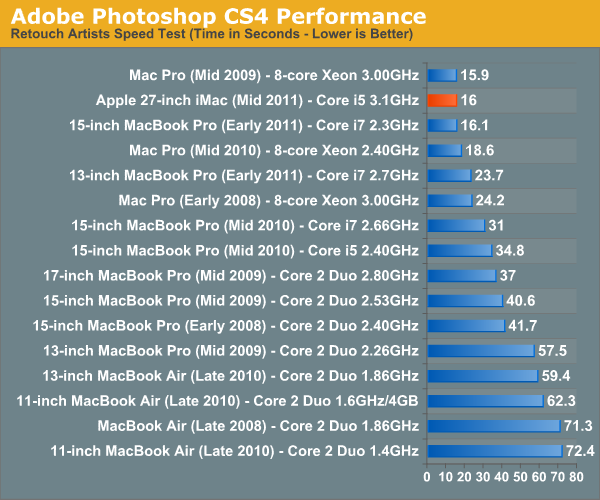
The high-end 27-inch iMac is a very capable Photoshop machine. A hair faster than the new MacBook Pro, the iMac delivers the same performance as an 8-core Mac Pro from 2009 or 2010.
Aperture 2 RAW Import
For my Aperture test I simply timed how long it took to import 203 12MP RAW images into the library.
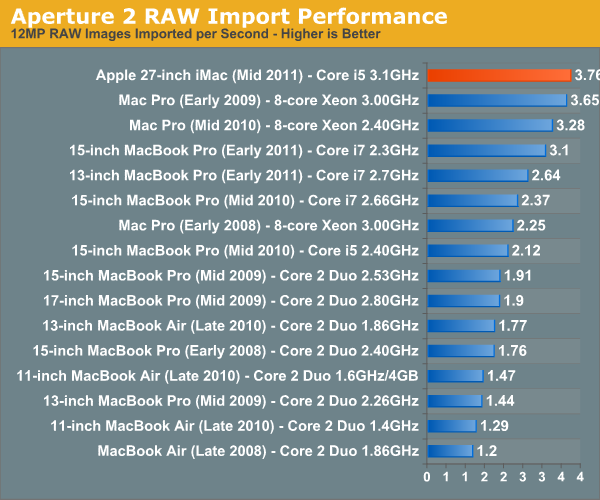
We have a new winner here! The MacBook Pros were always limited by their slower 2.5" hard drive, but the iMac with Sandy Bridge in additional to a speedier disk give us better image import performance than the '09 and '10 Mac Pros. I told you this thing was fast.
Cinebench R10 & 11.5
I’m a fan of the Cinebench tests because they lets me show off both single and multithreaded performance in the same workload. First, the single threaded performance:
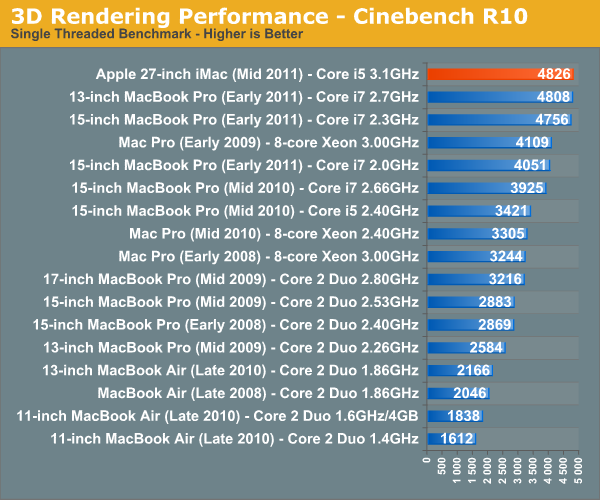
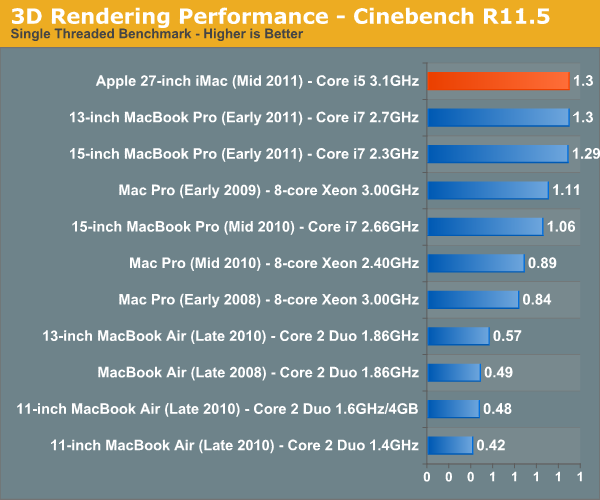
Sandy Bridge quad-core CPUs make no sacrifices. You get excellent single threaded performance which means general OS usage, launching applications and even rendering most web pages happens as fast as physically possible as the other cores are power gated and asleep. Start multitasking however and you'll see the Core i5 in this machine is no slouch:
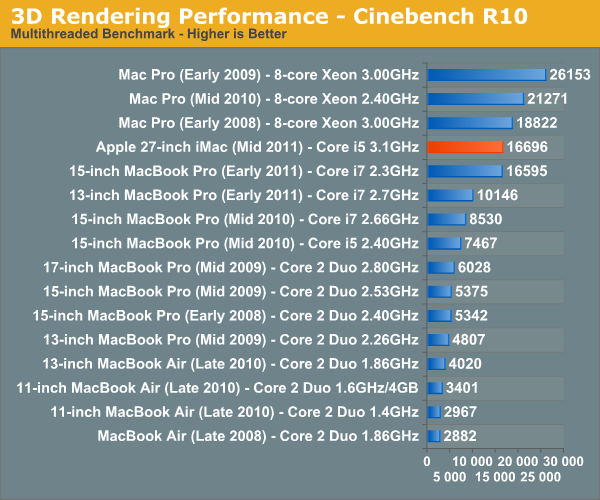
There's still no replacement for more cores when it comes to heavily threaded applications, the past three years of 8-core Mac Pros are still faster than the new 27-inch iMac here. I suspect the upgraded Core i7 would at least let the iMac beat the 2008 Mac Pro thanks to Hyper Threading, but the other two systems are simply out of reach. For those users, you're better off waiting for the Sandy Bridge-E Mac Pro update expected sometime in Q4.
You'll notice in Cinebench R10 the 15-inch MacBook Pro is nipping at the heels of the new iMac. Chalk that up to the larger L3 cache and Hyper Threading, both advantages enjoyed by the MacBook Pro. Look at what those advantages do in Cinebench R11.5's multithreaded test:
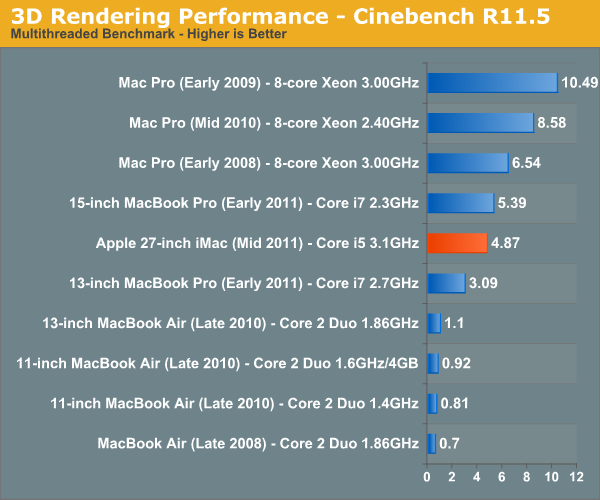
Here the MacBook Pro actually gains on the iMac. More threads and more cache are better suited for the Cinebench workload. If you do a lot of offline 3D rendering and you want the iMac, I'd suggest upgrading to the Core i7-2600 that Apple offers. You get a not insignificant boost in clock speed but more importantly, Intel switches on Hyper Threading which gives you twice as many threads.
Quicktime H.264 Video Encoding
Our final benchmark is more consumer focused. Here I'm taking an XviD and converting it to an iPhone-supported H.264 format.

QuickTime doesn't make tremendous use of all cores all of the time, and thus the MacBook Pro loses its threading advantage. The iMac is our new champion of this test.










139 Comments
View All Comments
Spazweasel - Friday, May 27, 2011 - link
Thanks for the clarification.Spazweasel - Friday, May 27, 2011 - link
So here's a question. While the display is in Targeted Display Mode, can the computer itself be active? It would be nice to be able to have the computer available for computation tasks, acting as a server, etc. on its own while the display was being used by an external device. I wouldn't expect it to be so, but perhaps you as someone with first-hand knowledge would know if it's possible.Thanks!
KoolAidMan1 - Friday, May 27, 2011 - link
Yes, the computer portion of the iMac can still be cranking away when the video signal is switched to another source. I've had it encoding video as I play Starcraft 2 or whatever on my PC, using the iMac as its display.It is pretty nice.
archer75 - Friday, May 27, 2011 - link
So I bought one of these imacs right at launch. Upgraded the processor to the 3.4ghz i7 and got the 6970m 2gb. Later got 16gb of ram on sale at newegg.In terms of gaming I only play at native resolution 2560x1440 and must say this imac does slightly better than my i7 920, 460GTX 768mb PC does at 1920x1200.
Crysis 2 on medium settings gives me frame rates in the 30-50 range which is perfectly fine for me. Medium doesn't look any different than high to me so i'm happy with that. Very smooth gameplay with Bad Company 2 and Portal 2. WoW on ultra settings is flawless. Civ5 plays well. Age of Conan at max is pretty smooth, not perfect but certainly better than my gaming PC. EQ2 runs very well at one step down from their super high ultra setting or whatever they call it. Running max settings with Dragon Age.
I have 7 other PC's in the house, 4 running Win7, 1 running WHS 2011 and the 2 others running XP. I built most of them. And I had debated building another gaming system or getting the imac and decided to mix things up a bit and must say I really do like the imac.
Bob Forsberg - Friday, May 27, 2011 - link
Just about ready to purchase a new 27" iMac to replace my white 24" 2.16GHz iMac from 4 years ago.You made choices easy on processor types as well as providing answers to many of my questions. Thanks for the thorough analysis of this great machine.
CharonPDX - Friday, May 27, 2011 - link
"I've always kept displays through several upgrades, but you can't really do that with an iMac."One thing Apple has implemented on their 27" iMacs since they added Mini DisplayPort is that you can use the iMac as a DisplayPort monitor.
So when this iMac gets replaced, you can continue to use it as a 27" display on another computer with DisplayPort video. Be that another iMac (and have two displays), a Mac Pro, a Mac mini, or even a PC with DisplayPort (as most Dells have now.)
I know a customer that has two last-gen iMacs side-by-side: One as his workstation and one as a secondary display and VM host. He interacts with the VMs remotely from the 'workstation' machine, and has two 27" high-res displays on his primary system. If he ever really needs to interact locally with the VM machine, he just plugs a keyboard and mouse directly (although he generally VNCs over.)
tipoo - Friday, May 27, 2011 - link
Actually these new ones will only work with Thunderbolt, not DP unfortunately. So for now, just the Macbook Pro's can use it. The last gen could work with any displayport connection so its a step back IMO.tipoo - Friday, May 27, 2011 - link
I'd really like a decibel reading for a few computers in future reviews. ie, you say the MBP is loud, but how loud? I'd like to see it compared to other popular laptops at idle and under load.Hubb1e - Friday, May 27, 2011 - link
To understand an iMac usage model, you have to get over your idea that you upgrade your PC components. When you outgrow the GPU, you simply upgrade the whole Mac and sell the old one on the used market. The used market for these things is huge so you really aren't dropping much cash by ditching the old model for a new one. You aren't really ditching the monitor, you're simply making an upgrade for the GPU and a new screen comes with the upgrade. It's typically a sideways move in screen quality and you aren't losing any real value there by replacing it. You might drop $600 (accounting for taxes) when you drop the iMac after 1.5 years, but you get $400 worth of GPU and CPU upgrades. So, you do pay a bit for the Mac experience, but I think you can still keep the upgrade path going with a Mac.Keep the box and it's super simple to unload a used Mac.
dingetje - Saturday, May 28, 2011 - link
is there any chance of a review of some 16:10 screens? for instance ASUS PA246Q